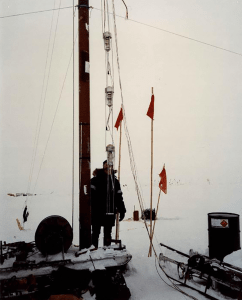AMANDA test string proves feasibility of an in-ice neutrino detector
In a 1991 Nature paper, Francis Halzen, Bob Morse, Buford Price, and other collaborators described the initial results of the AMANDA (Antarctic Muon And Neutrino Detector Array) project, which tested the feasibility of using ice to detect neutrinos with instruments deployed on the summit of the Greenland ice sheet. The paper outlined the reasons why deploying a larger detector in the Antarctic ice sheet would be a good idea. Today, the paper’s abstract has proven to be incredibly prescient:

“Detection of the small flux of extraterrestrial neutrinos expected at energies above 1 TeV, and identification of their astrophysical point sources, will require neutrino telescopes with effective areas measured in square kilometres—much larger than detectors now existing. Such a device can be built only by using some naturally occurring detecting medium of enormous extent: deep Antarctic ice is a strong candidate. A neutrino telescope could be constructed by drilling holes in the ice with hot water into which photomultiplier tubes could be placed to a depth of 1 km. Neutrinos would be recorded, as in underground neutrino detectors using water as the medium, by the observation of Cerenkov radiation from secondary muons. … Our results suggest that a full-scale Antarctic ice detector is technically quite feasible.”